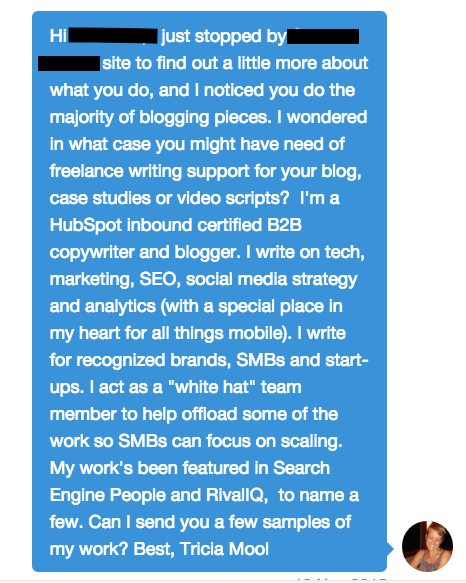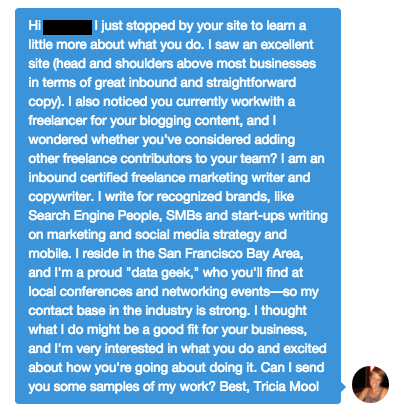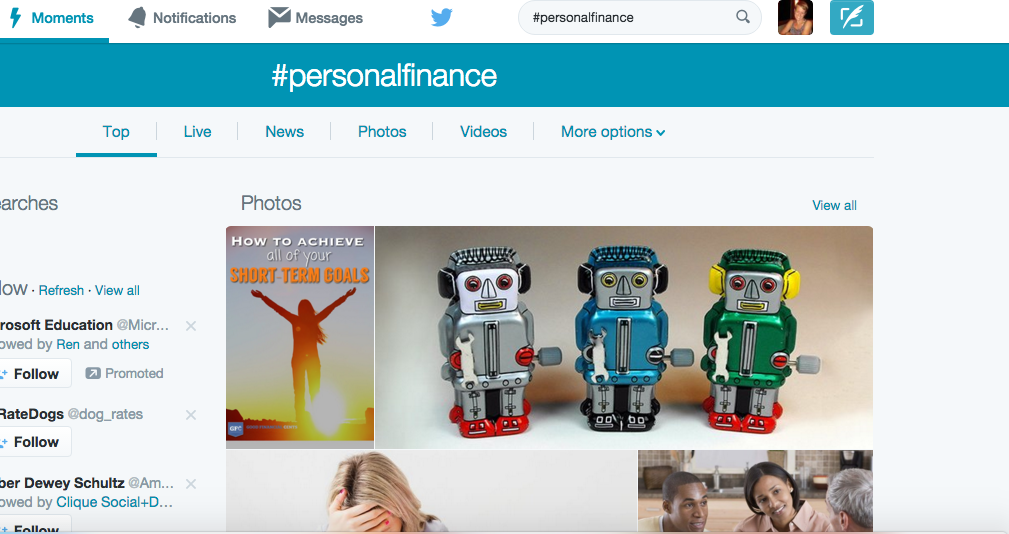
But if you’re like me, you secretly hope your marketing efforts could be simple, painless, and effective.
While it definitely takes hard work, consistency, and perseverance to build a freelance writing business, sometimes you can find a sweet spot that works brilliantly and is surprisingly easy.
I recently found a marketing method that’s getting great results for me. It uses Twitter, direct messaging, and a simple “ask.”
This Twitter marketing approach produced the best results I’ve had since I started my freelance business – netting over a 35 percent response rate. It led to two well-paid, longform blog posts and feedback from five prospects who liked my portfolio and are keeping me in mind in for 2016 projects.
Here’s how you can get these results, too:
Connect with your Twitter followers
This past summer, Twitter changed its platform, abandoning the 140-character limit for direct messages.
I’ve found Twitter to be an integral part of my business. I build connections there, share useful content with my followers, and keep up on the latest trends in my niche.
I’ve built connections by re-tweeting, replying, and favoriting my followers’ content. It just felt like the natural next step to reach out to followers who might be in need of extra writing support. Doing so via a direct message proved to be a good strategy.
In the first day, I received six responses to the ten DMs I sent. It took perhaps 40 minutes to get a 60 percent response rate that day.
I received requests for rates, generous email responses about company growth and where they see a freelancer fitting in, and requests to follow up at a future date. A few started following me, because they were interested in hiring me. Not bad!
After I sent more messages, I got about a 37 percent response rate overall – 15 responses to 40 messages.
Most companies worth having as clients have a presence on Twitter, and marketing managers check their accounts daily. The Twitter DM platform creates a more laid-back environment than email, and seems to invite more responses and faster response times.
But knowing how to target prospects is important.
Use a targeted approach
I’m not suggesting you go crazy and reach out to every tweep you’ve got.
In fact, although the actual marketing takes me minutes, I spend more time building relationships and my own brand on social media.
That’s why my Twitter marketing strategy gets prospective clients to respond:
- They see my Tweets regularly.
- They know I’m consistent in my message and keep a professional demeanor.
- They hear from me, they see me share their content – and I make it a point to click on their content and take time to read it and learn.
To sum up: good will, interest, consistency, and authenticity are why this form of marketing works.
Find out how you can help
I target marketing managers and contacts in my niche. I review their sites and ask myself the following questions:
- Has their blog been updated?
- Does the same internal person post all the time? Might they need extra support? You can almost feel how hectic their day-to-day schedule is when you see a small business with a marketing manager who is doing all the posting.
- Are their calls to action and landing pages strong?
- Are they a start-up? Do they need a writer now, or maybe once their site is out of beta? It’s easy to find out if start-ups have seed money. A quick search on AngelList or CrunchBase can help you qualify a prospect.
- Do you get the sense that it’s a fantastic company you’d love as a client? Is it a high-quality site, full of interesting testimonials, great writing, and a winning product or service? If so, they may need support in writing white papers, case studies, company profiles, or e-books.
If you like what you see, don’t overthink it. Send your tweet. One minute of your time is worth it.
Make your request short and simple
Exactly what do I write to get a high response rate on Twitter? I call these messages mini-LOIs (letters of introduction).
They aren’t that different than any other letters of introduction I send. The only change I make for the Twitter DM format is to condense my message to the bare essentials:
- What I like about their site. A sentence about their site is all that’s needed.
- Where and how I could add value. Could I support their blogging team, provide tighter copy, or is the company at the point in their content strategy plan they need additional content, like a case study or video script?
- My credits. I include a few sentences about the companies I have worked with and the results I’ve produced.
- The ‘ask’. I ask where they might have need for writing support and if I can send them samples of my work. Notice I don’t ask whether they need a freelance writer. Open-ended questions create richer responses, and your awesome writing skills can greatly help a stressed-out marketing manager or busy CMO.
If they request samples, let your work do the talking from there.
Once you’ve written your first mini-LOI, modifying and personalizing it is simple. You’ll be able to keep it lean and personal for each of your followers.
Here’s a sample of what I write:
Yes, it’s that easy. I didn’t need to include many details to get a response.
You can add a value proposition about how your writing can uniquely serve that particular organization. As a value proposition for one company, which I found particularly interesting, I included how my location and access to industry contacts could be beneficial to them:
New to Twitter? No problem.
In case you think I’m a Twitter superstar, think again. I have less than 1,000 followers — though I’m focused on growing my community, one targeted follower at a time.
For marketing purposes, a pool of 1,000 followers can generate hundreds of targeted prospects.
Don’t feel discouraged if you have a small following. Take time on Twitter to share information your followers might find helpful, target followers you would like as a client, and interact with them because you’re truly interested.
Use Hashtag Searches
Do a hashtag search of potential followers and follow them. Most of the time, if you follow someone in your industry or niche, they’ll follow you back.
Take 15 minutes a day to scroll your feed, comment on great content, and be a part of the community.
Think about words related to your industry. I typically search using #contentmarketing or #startup, and I look for marketing managers and business owners in tech and digital marketing.
Do you write on finance, healthcare or pet care? Using your Twitter search bar, try searching for prospects to follow by typing in a word that’s unique and common to your niche, and include a hashtag in the search.
If you write on personal finance, keep it simple and try #personalfinance like in my example. You can choose from a number of filters, like the “Top,” “Live,” or “News” tweets that include the hashtag. Then, scroll through these results to see what companies and people you find, and follow companies and people in the niche.
With just a few hours of work, I’ve added to my list of leads to follow up with in 2016. I also landed an ongoing monthly blog post assignment that averages a $50 an hour rate, with an easy-to-work with company.
As writers, the way we use our time is crucial for making a good living, and it’s a thrill to hit on a marketing sweet spot.
What marketing methods are getting good response for you? Share you successes in the comments.
Tricia Mool is a marketing and lifestyle writer for start-ups, universities and brands. For simple lifestyle hacks and straightforward small business marketing tips follow her @teejaywrites.












